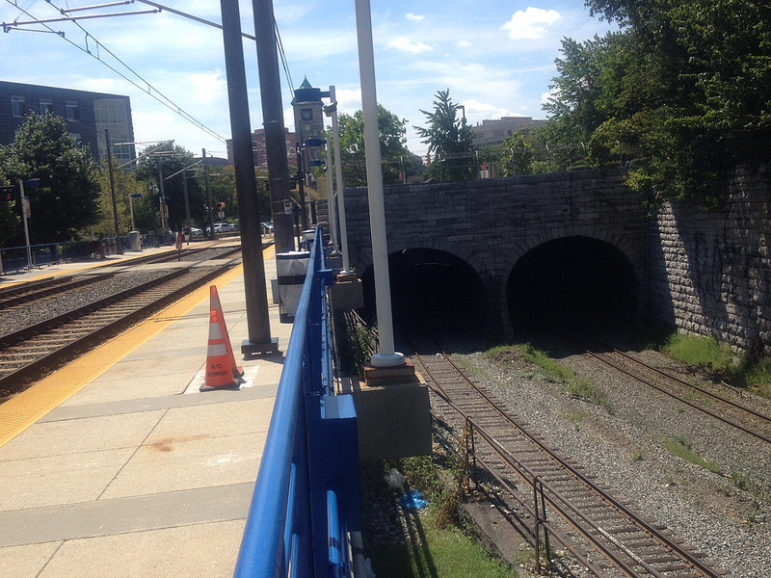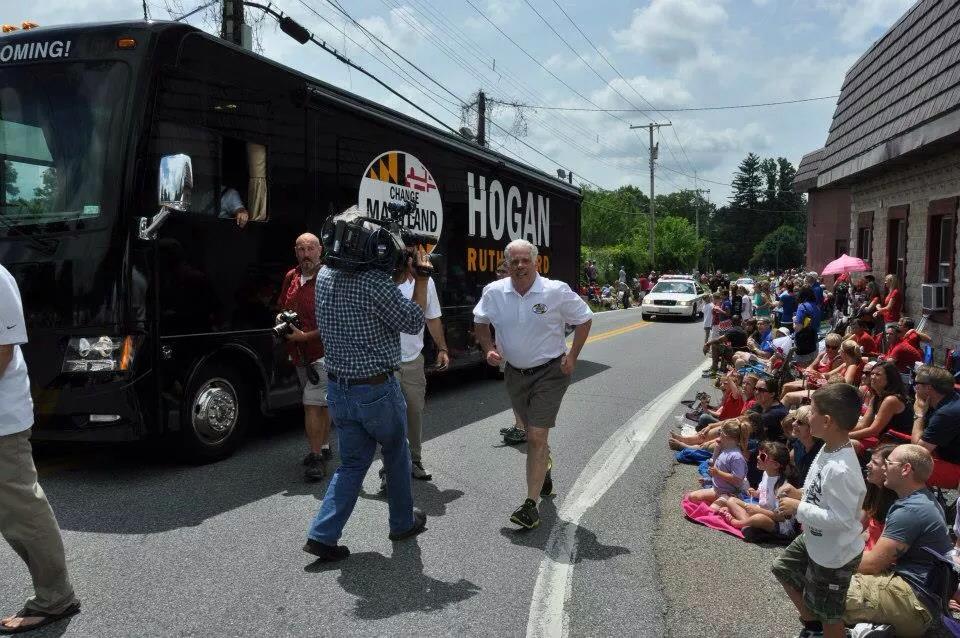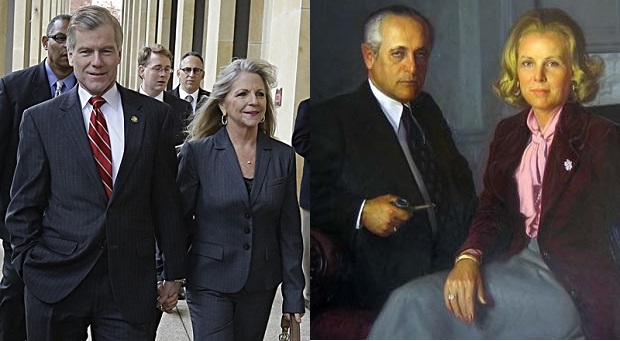By Richard J. Douglas
For MarylandReporter.com

Howard Street Tunnel, right, with the Central Light Rail line on left. Photo by charmcity 123 with Flickr Creative Commons License.
If shippers can’t get their cargo in or out of a seaport quickly, what happens? They route their cargo to a more efficient port and take jobs with them. If you grasp this concept, then you will grasp Baltimore’s Howard Street railroad tunnel problem.
In the logistics and transportation world, cargo-in-motion makes money. Cargo at rest doesn’t. Rail or road bottlenecks slow things down and hurt profits.
The Port of Baltimore is afflicted by a longstanding bottleneck at the Howard Street Tunnel, the subterranean railway which carries cargo through the heart of the city. The tunnel was built in the 1890s when railway technology was much different Today, the 19th century tunnel cannot accommodate 21st century “double stack” rail cars.
What is a “double stack” rail car? If you see a railroad flatcar carrying two colorful shipping containers stacked one atop the other, you are looking at a double stack rail car. But you won’t see them around the Port of Baltimore.
There isn’t enough overhead clearance in the Howard Street Tunnel to get double stacked flat cars through. Only single stacked cars fit.
The bottleneck
Thus, the bottleneck effect in the Port. Shippers know this, so many probably found alternatives long ago. For Baltimore, that means cargo and jobs lost to competitors like Norfolk, Philadelphia, or Wilmington.
For three decades, double stacked flat cars have been a familiar sight on the nation’s railways. But not around Baltimore. Now it’s 2016. Why hasn’t Baltimore’s bottleneck been removed? Doesn’t it make sense to make the port more efficient to attract more cargo?
This year Gov. Larry Hogan tried to solve the tunnel problem by requesting funds to enlarge it from the U.S. Department of Transportation (DOT). Last week DOT refused.
U.S. Rep. Elijah Cummings acidly implied DOT retaliated against Hogan for opposing the Red Line light rail project. The Baltimore Sun suggested the governor attached insufficient priority to a problem which predates his administration by three decades.
Democrats have the power
But facts are stubborn things, and here are a few. DOT is in the hands of a Democratic administration in its eighth year.
- All but one of Maryland’s 10 “defenders” on Capitol Hill are Democrats.
- The senior House Budget Committee Democrat, who also wants to be your next U.S. senator, is a Marylander.
- The two most senior Democrats in the U.S. House of Representatives are both Maryland natives.
- The senior Senate Appropriations Committee Democrat is from Fells Point. Maryland’s other Democratic U.S. senator is on the Transportation Subcommittee of the Senate Environment and Public Works Committee.
Pulling together, couldn’t all these heavy-hitting Maryland Democrats have persuaded DOT to fund tunnel modernization? Absolutely. But they didn’t.
DOT’s refusal wasn’t because the governor didn’t make the project a priority. Transparently, it was because Maryland Democrats on Capitol Hill did not move a muscle to help. In fact, some may even have encouraged DOT to shoot down the governor’s request to deny him a “win.”
Jobs at stake
Why does congressional failure matter? Jobs. Seaports are economic engines. By making itself more competitive, and increasing cargo velocity, a port makes itself more attractive to shippers. A port that attracts more cargo needs more manpower to handle it.
In recent years, the Port of Baltimore has taken steps to improve competitiveness and attract more cargo. In 2013, the port installed new cranes at Seagirt Terminal to prepare for larger ships expected to transit a widened Panama Canal. It was a good investment, but the Howard Street tunnel bottleneck could undermine it.
By removing the Howard Street Tunnel bottleneck, the Port of Baltimore will be able to take better advantage of its first class terminal infrastructure and human capital, its enviable position at the center of the mid-Atlantic coastline, and its geographic proximity to the heartland.
Improving cargo flow to and from the port will mean job creation, as the port becomes even more attractive to shipping. A busy port means jobs on the terminals and off-port where cargo is manufactured, packaged, inventoried, containerized, verified, marshaled, inspected, and trucked.
Voters should take this into account
In October, the Hogan administration will ask DOT again for assistance with the Howard Street Tunnel. In November, Maryland voters ought to recall that their governor is making good faith efforts, the first in recent memory, to address the tunnel problem. They should ask themselves whether the incumbent politicians on their ballots are part of the Tunnel problem or part of the solution, and vote accordingly.
Gov. Hogan is trying to do the right thing for the Port of Baltimore and for job creation in the region. Maryland’s Capitol Hill delegation should do its utmost to lend a hand.
Maryland lawyer Richard Douglas was staff counsel at the National Association of Stevedores in the 1980s.







I’ll second Charlie Hayward’s points. This op-ed is a silly attempt to generate blame for partisan purposes. To understand the political realities, look at the list of approved projects. US DOT made large grant allocations to the Port of Savannah (represented by a freshman Republican), to Louisiana (5 of 6 Representatives and both Senators are Republicans), and to Oklahoma (home of Senator Inhofe, who is a leading opponent of the President). If Maryland wants to succeed with a follow-up application, it will need to be more selective (drop the Port Covington competitor) and more persuasive. The latter probably means getting CSX to contribute more.
MDOT applied for a FASTLANE Grant for the Howard Street tunnel project and did not receive it. Most likely because there were 212 applications totaling $ 9.8 billion for $ 800 million in available funds for 2016. I seriously doubt the Congressional delegation did not support MDOT’s effort.
The Federal Department of Transportation, not Maryland’s congressional delegation, decides which projects from among a nationwide group of grant applicants warrant Federal grant money. Casting blame on MD’s delegation strikes me as a politically-motivated argument which gives short shrift to the competitive grant award process extant at DoT. Would the author prefer that congressional delegations have greater authority for DoT grant awards? I doubt it.
So if the delegation is not responsible (even at the margins?) why the acid remarks from Rep. Cummings about the Governor’s responsibility.?
I can’t find any quote or video from Cummings on this, and I’m disinclined to trust the author’s version. Cummings usually knows better than to talk such nonsense.
“I hope that when Governor Hogan walked away from $900 million in
federal funding for the Red Line — more than all of this year’s FASTLANE
grants combined — he didn’t do irreparable damage to Maryland’s ability
to compete for discretionary federal transportation awards in the
future,” Cummings said in a statement.
Article from Baltimore Sun on Jul 6, 2016. Tried to post the link but Disqus did not like it.
Thanks; that’s just hot air or, if you prefer, nonsense, from Cummings.